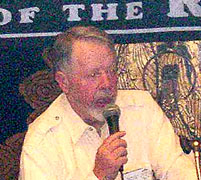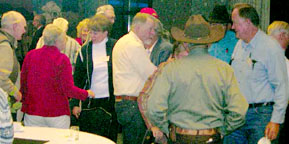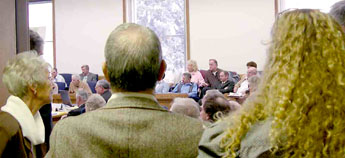|
Hage v. U.S.
AgLifeNW
Magazine
November Issue by Scott
Johnson, AgLife editor 11/15/04
Stewards of the Range held a gathering October 20 at
the Peppermill Casino in
Reno, Nevada. Friends, supporters and well-wishers
gathered one more time to
show their backing for Nevada Rancher Wayne Hage and
more importantly their
increasing concern for modern day trampling of
property, water and civil rights
by various government agencies.
After more than a decade of harassment, being forced
out of business the only
alternative was the court for Wayne Hage. Excerpts
from the trial, and
information provided and gleaned from various
sources will be passed on to you, the
reader, to draw your own conclusions.
 |
Keep in mind that what happens
to your neighbor two blocks away, or two
states away ... you could be next. If your
neighbor wins his battle ... you might
not have to fight an expensive battle of your
own!
Hage testified that when he purchased the ranch
in 1978, he understood he
purchased "the entire ranch", which included
numerous holdings of private
property and the neighboring grazing lands
adjudicated by the Forest Service and
Bureau of Land Management, range improvements,
ditch rights of way, water rights,
wells, road system, trails, fencing and other
necessary components of the
ranch. |
In the
trial Hage detailed how the Forest Service worked to
make it
increasingly harder to operate an efficient
livestock operation, ultimately leading to
the taking of his ranch. When a 2,000 mother cow
operation sees the income
drop from 400,000 a year to $6900 ... it would be
hard to survive.
A teacher, cable guy or policeman couldn't stand a
pay cut from $40,000 a
year to $690 a year.

gathering of friends
and supporters |

standing room only
in the courtroom |
Hage testified how the Forest Service began fencing
off his springs, blocking
cattle from the water. Their justification was that
they "thought" the
recently enacted Federal Land Policy and Management
Act gave ownership of the water
in the National Forests to the Forest Service.
Shortly after that, the Forest Service expanded
their horse pasture next to
an administrative site in Meadow Canyon, taking in
Hage's primary spring
system, which watered the cattle on the Meadow
Canyon allotment. Hage objected to
this and the Nevada State Water Engineer held a
field hearing with the Forest
Service and Hage. At the hearing, Hage brought title
documents showing ownership
of the water. The Forest Service had nothing. The
engineer ruled that Hage
owned the water. "Even though I won the ruling, the
Forest Service wouldn't take
out the fences that blocked my water," Hage said.
Those fences remain today.
In the trial Hage spent a considerable amount of
time answering questions on
the charges filed against him by the Forest Service
and the BLM. Most of these
were trespass notices and complaints of not
maintaining fences. During a
105-day grazing season in 1983, the Hages had 40
personal visits and 70 certified
letters from the Forest Service, all alleging
different violations. One notice
he received gave him the usual 5 days to fix the
fence. He sent a man with a
pack horse hauling fencing equipment to the top of
Table Mountain. When his
rider found the Forest Service's blue flag marking
the maintenance problem,
there was one staple missing.
The previous owner told Hage he was selling because
of the increased Forest
Service pressure, but Hage thought he could get
along with them. "You might say
I was a bit naive. I had worked for the Forest
Service and BLM, taken more
range courses than most of them had, so I thought I
could work with them, but
quickly found out it had nothing to do with good
range management, but that they
didn't want me there."
Hage also discussed his decision to take non-use on
Table Mountain. He
explained that with all the new policies, new fences
they erected which inhibited
proper grazing, and continual charges they brought,
he decided to take non-use
while appealing their decisions. He notified the
Forest Service of this through
a letter sent by his attorney.
In response, the Forest Service suspended 20% of the
cattle allowed claiming
Hage did not fill out the proper form to take
non-use. Then with 30 days left
in the permitted grazing season, they informed him
he was required to place at
least 90% of the cattle on the allotment. Hage knew
there wasn't enough time
to place cattle on the allotment and remove them
without creating more
trespass situations. (Note, it is 80 miles from one
end of the ranch to some
allotments).
The next letter he received cancelled 25% of the
cattle allowed because the
Forest Service did find cattle on the allotment.
Hage explained what led to
this letter. The cattle that normally summered on
the mountain would stay close
to the gate at the head of the trail. One day, Hage
and his crew saw a Forest
Service vehicle drive up to the gate and then leave
shortly thereafter. Curious
as to what they were doing, he went to the same
location, found the gate open
and saw cattle tracks going through. A few days
later he received a letter
cancelling 25% of his permitted numbers.
At this point Judge Loren Smith asked Hage if his
testimony was that the
Forest Service opened the gate, cattle wandered onto
the allotment and the Forest
Service filed trespass charges against him. Hage
responded, "That is correct."
Hage's attorney Ladd Bedford then turned to the next
grazing season and asked
what efforts Hage made to contain the cattle. Hage
explained that by 1991 the
only way to comply with the cancellation of the
Meadow Canyon permit and the
severe reduction already made on Table Mountain, was
to remove all the
livestock from his grazing allotments. In the Spring
of 1991, as the cattle moved off
the winter range, he began gathering and placing
them in private meadows
until the controversy could be resolved. But, 1991
turned out to be a very dry
year so he wasn't able to hold the cattle for long.
In order to move the cattle from the Ralston Range
to Pine Creek private
pastures, the cattle had to migrate through the
Monitor Valley allotment which
borders the now suspended Meadow Canyon allotment.
"From June 1 to July 27 our
crew gathered the allotments every day."
Bedford asked what happened July 27, 1991, the first
day they confiscated his
cattle. Hage explained his crew was met with several
riders and Forest
Service officials wearing bulletproof vests and
carrying semi-automatic weapons.
After the Forest Service confiscated the cattle,
Hage received a letter
informing him he would need to pay $39,000 for the
cattle, and $40,000 for the cost
of impoundment. Unable to pay the costs, the Forest
Service District Ranger
David Grider personally auctioned the cattle off at
a BLM facility.
Bedford then asked a series of questions regarding
the issues that arose
after Hage filed his takings case. The BLM had
issued temporary permits to other
ranchers who were now using Hage's range and water.
Although the ranchers were
required to haul in the water, the cattle would
still use Hage's wells and
springs.
Hage talked of an incident in 2001 when his crew was
moving cattle from one
private pasture to another. They were driving the
cattle down a country road
when a BLM vehicle forced the cattle off the road.
The agents stopped and took
pictures of the scattered cattle. Later they sent
Hage a trespass notice.
Hage discussed a number of other issues that
occurred, all showing a pattern
of retaliation against him for filings the takings
case. The one and a half
days of direct testimony filled the record with
numerous accounts of calculated
government actions designed to run this rancher out
of business without due
process or compensation. But the government would
have their chance to refute
Hage's accusations, first on cross-examination and
through testimony of their
witnesses.
They failed. Hage's testimony held up under cross
where the lead attorney for
the government was unable to impeach or discredit
Hage on any issue. The
remaining plaintiff's witnesses also held up under
cross.
When District Ranger David Grider was on the stand
it was quite a different
matter. Court watchers witnessed the arrogant
district ranger slowly unravel.
Before noon on the first day of cross, Grider had
impeached his testimony four
times. Four different lines of questions followed
the same that been asked
during his deposition many years earlier. But today,
he gave different answers.
Bedford would ask his question, Grider would answer.
Then Bedford would ask
Grider to read portions of his deposition into the
record. How strange it must
have been for Grider to read out loud the same
question just asked and his
answer which was opposite of that just given. Then
Grider would put down his
deposition and push it off to the side.
This gives you, the reader, a small sample of the
total picture. If you are
even remotely connected to agriculture and care
about property rights, water
rights and your civil rights ... you should perhaps
take a harder look at things
that are affecting someone else ... you might just
be next.
To learn more you can go to
www.stewards.us.
|

